
- Free Article: No
- Review Article: Yes
- Article Title: Goldfields and Grand Pianos
- Online Only: No
- Custom Highlight Text:
Forgotten histories and lost objects of Australia: this is a five-star title for a three-star book of essays. Several of the essays are slight and pedestrian, and overall the subject of gold gets a patchy treatment; the contributors write about their specialties and we are not given much help to reach a new understanding of the whole phenomenon. But there is much that is interesting here; and some of the material is arresting. The editors have fulfilled their modest intention – ‘to illustrate, amplify, complicate or update’ well-traversed themes.
- Book 1 Title: Gold
- Book 1 Subtitle: Forgotten Histories and Lost Objects of Australia
- Book 1 Biblio: CUP, $49.95 hb, 344 pp
- Book 1 Cover Small (400 x 600):

- Book 1 Cover (800 x 1200):

- Book 2 Title: Gold and Civilisation
- Book 2 Biblio: Art Exhibitions and the National Museum of Australia, $39.95 pb, 220 pp
- Book 2 Cover Small (400 x 600):

- Book 2 Cover (800 x 1200):

The rapid re-establishment of order or its continuity through the rush is a theme of several of the essays. At Bendigo, explains Charles Fahey, large-scale mining was operating by the early 1860s, with the most important element in the labour force being skilled miners attracted directly from the UK, particularly the tin miners of Cornwall. Margaret Anderson, writing about women on the goldfields, reports that people with shady pasts thought that the goldfields offered anonymity but everywhere there were people from the same county in Britain or the same district in a neighbouring colony or off the same ship. Migrants came with relatives or encouraged them to follow, so that networks of kin were quickly established on the fields. And the tents were not all the same: within one at Castlemaine were sofas, armchairs and a grand piano. Ladies on the goldfields wanted to be known as such.
Some of the tents were soon firmed up into cottages. Susan Lawrence, in her archaeological work at the Moorabool diggings in Victoria, unearthed a sandwich of paper, fabric, and tin with the original calico of the tent in the middle. And the inhabitants of these tiny habitations on a poor man’s diggings were not eating off tin dishes, but ceramic plates. Around the tents and cottages, as well as the mansions of the wealthy, gardens were soon flourishing, which is the subject of Suzanne Hunt’s essay.
Graeme Davison identifies the birth of the Australia suburb, the essence of good order, as a response to the overcrowding of gold-rush Melbourne. The city centre was never more lively; young men doing only their sleeping in crowded houses and everything else in the street and public places. To solve the overcrowding, the government suspended the operation of the building code which allowed men with families to put up small wooden cottages each on its own block beyond the city.
The book does carry us further in time and place than the customary accounts. In a section on immigrants and ethnic relations, Ann Curthoys repeats the story of the anti-Chinese agitation at Lambing Flat and the belated imposition by the NSW parliament of restrictions on Chinese immigration (and oddly thinks that this colony was unusual in having pastoralists in its upper house). The essay on Western Australia’s racial restrictions continues into the 1960s and 1970s. The restrictions on the employment of Asians in the mines were still in place when the Japanese wanted to send their own surveyors and engineers to the mines they owned. In the 1960s, the Australian Workers Union, the RSL and the Labor Party opposed the lifting of this ban. It was not completely removed until the 1970s.
Hank Nelson writes of Australian gold-miners in New Guinea, their relationship with the locals, and of the locals becoming miners in their own right. In a fascinating study, Derek Elias explores how the Warlpiri people of the Tanami Desert have related to mining. When mining was small-scale in the 1920s and 1930s, they were exploited as labourers, but they did not want the mines to go because they supplied water and other goods and so gave a new stability to their lives. Now that large companies are exploring all their land, which the Warlpiri hold on native title, they can move around it more readily, which has led to a revival of traditional culture.
The lost objects of the title are vividly presented in the numerous illustrations, many of them in colour. There are the drawings of Queensland native police on the Palmer River made by an Aboriginal boy (an amazing find), the brooches made out of Western Australian gold, Fauchery’s photographs, the canvas panoramas of gold rush life, the illustrated gold-rush diary kept by Edward Snell, and drawings of diggers and Aborigines on the early Western Australian fields. The drawings of W. Hodgson depict subjects which as far as I know have not been represented anywhere else: a digger flirting with an Aboriginal woman, another offering an Aboriginal woman a tin of salmon in return for sex, and a digger writing home to his wife with his ‘black velvet’ visible outside his tent.
The new National Museum helped in the production of this book, which appears as the Museum opens and complements its first special exhibition, ‘Gold and Civilisation’. The Museum has also produced a sumptuous catalogue to the exhibition, which contains coloured illustrations of the objects displayed and substantial scholarly essays. The Australian essays in the catalogue deal with Life on the Early Goldfields, Art of the Goldfields, Gold and Australian Decorative Arts, and Australian Jewellery. These are valuable surveys, and the treatment is more comprehensive than in Gold. In the latter, there is an essay on Western Australian gold brooches; the catalogue essay deals with Australian brooches.
Geoffrey Blainey put his distinctive stamp on the story of gold in The Rush That Never Ended, first published in 1963. Only one of the Gold essays challenges his work. Charles Fahey disputes Blainey’s judgement that in capitalist-mining industrial relations were fairly harmonious because the workers were also shareholders and often working not for wages, but a share of what they mined. Paul Pickering, writing on gold’s effect on New South Wales, matches Blainey in bold simplification when he declares that Canberra is a result of the 1850s gold rush (because it produced in Melbourne a rival to Sydney). But this boldness is unusual in the Gold essays. Their strength is suggestive; they point to a richness of material that a new interpretation might encompass.


Comments powered by CComment